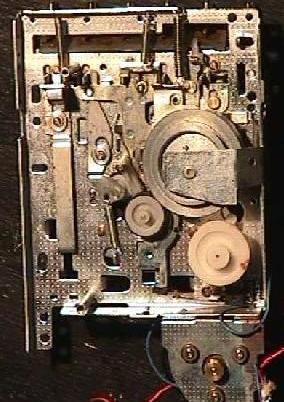From
WM-D6
WM-D6
(1982)
The WM-D6 at first looks like a rather large personal stereo, but is really more like a miniaturised TC-D5 portable cassette deck. Although the WM-D6 was not the first Walkman model that could record, it was the first that could do so to such high standards that it was suitable for professional use.
The WM-D6 used a very similar mechanism to that of the TCM-600 and the TPS-L2. The similarity is evident in the layout of the controls and tape transport components. However, to raise the quality to the high level demanded, the mechanism was upgraded by fitting a disc drive capstan servo similar to that of the TC-D5. Inevitably all the parts had to be made smaller, but the principles remained the same. One would have thought that this would be enough, but the designers took the disc drive concept one stage further and made it quartz controlled. At a stroke, this removed any possibility of drift or error, and gave the WM-D6 perfect speed accuracy under all conditions. The system worked by comparing the output of the capstan tacho sensor with the divided-down output of a quartz crystal oscillator. The servo ensured that the two signals were locked together by varying the motor speed. As the quartz crystal frequency never altered, neither did the tape speed. The user was given the option of bypassing the system and setting the tape speed manually by up to 4% using a small dial at the rear of the machine. In this mode, the servo operated as it did in the TC-D5. The switch that controlled the variable speed function was mechanically interlocked to the record key and so was automatically returned to the quartz locked fixed speed mode whenever a recording was made.
Other features carried over form the TC-D5 included the ferrite heads and the DC-DC converter, which enabled the electronics to operate at a higher voltage than the batteries would normally provide, improving the sound quality. There was no room to accommodate the TC-D5s large moving-coil meters so the WM-D6 used a single LED bar graph display instead. This could also be used to give an indication of battery condition. An input was provided for a microphone, though using the switchable attenuator this could also accept signals from an amplifier or second recorder. The limiter function from the TC-D5 was not carried over, so recording level control was manual only. Two pairs of headphones could be connected. A three position tape selector switch allowed normal, chrome and metal tapes to be used for both recording and playback, though the selection was manual, not automatic as it had been with the TC-D5.
Power was usually provided by 4 AA sized cells, though the battery compartment was designed so that the standard Sony Ni-Cd pack could be used too. This could be recharged in situ from the DC input socket.
The WM-D6 was expensive but was also capable of outstanding performance, better than many full-sized cassette decks. It was quickly adopted by radio stations and news organisations as the ideal machine for reporters to use. It also became a favourite for making high quality but discreet bootleg recordings at concerts. It was replaced by the improved WM-D6C.
About WM-D6C
This updated model added to the strengths of the WM-D6 by offering an important extra feature: Dolby C noise reduction. This system, which operated in playback and record, improved the dynamic range considerably. Including Dolby C noise reduction in a compact portable was not easy, and the integrated circuits which performed most of the functions had to be made by Sony themselves. The fact that this extra function could be fitted to the WM-D6 without making it any larger was amazing, though it forced some changes, for example the second headphone socket was no longer fitted.
Other useful modifications were made at the same time. Most useful of these was the addition of a line-in connector, which allowed direct connection to other audio equipment without having to use the microphone socket. This was a great improvement and helped to reduce the background noise level when recordings were made from line sources, such as a CD player, second tape recorder or a mixing desk. The level meter was also altered so that as well as showing the recording level or the battery condition, it could be switched off to save battery power.
The WM-D6C could easily be identified from the earlier version as the professional script on the top cover was changed from green to yellow. The WM-D6C could not really be improved upon and so remained in production almost unaltered for many years. The only change of real interest was that in later production units the printed circuit was re-drafted to use surface mounted components. These were much smaller than the types used originally, though as the size of the recorder stayed the same the only advantage was a reduction in the cost of assembly. The circuit remained substantially the same as before and offered identical performance.


